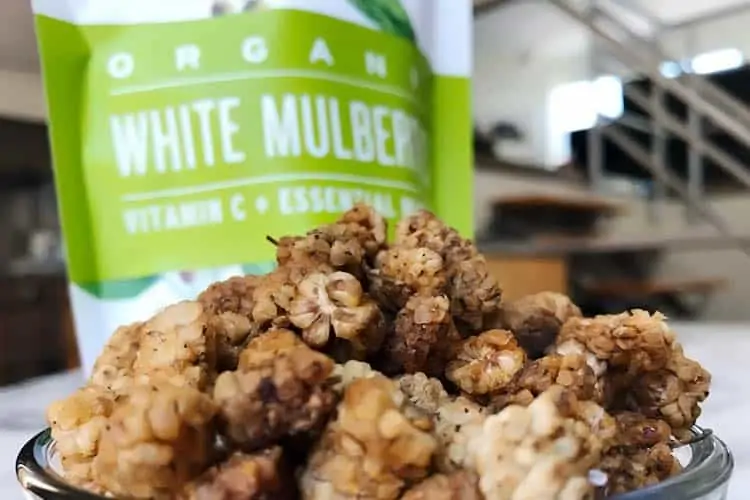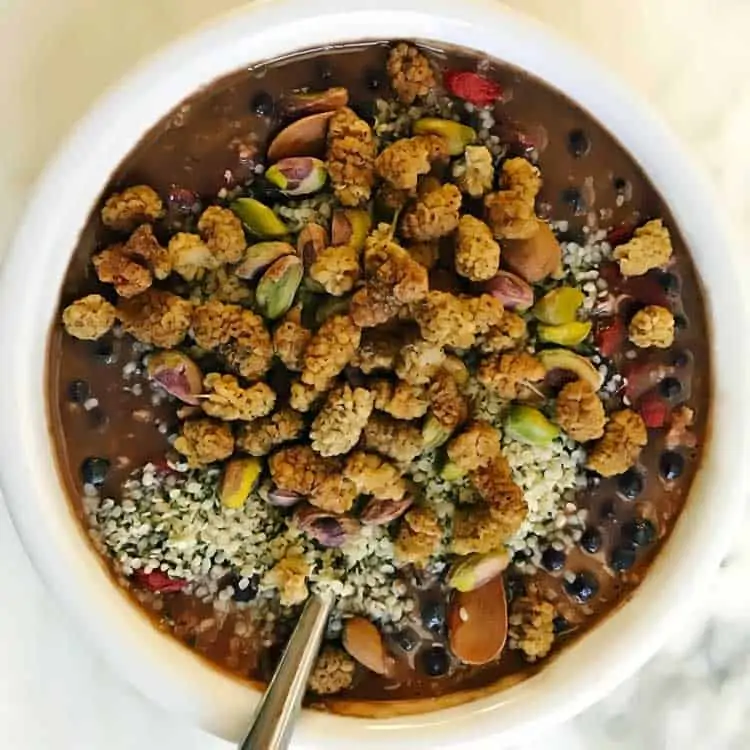[toc]Why did the cities of Las Vegas, Tucson, El Paso, Albuquerque and others ban the growing of this tree?
Its pollen count is out of control. Before the ban in Albuquerque, there was up to 300% more pollen produced by these versus the 2nd largest contributor, juniper trees (1).
That may sound like a nasal nightmare – and it is – but that’s only when the flowers are in bloom.
Later on you get the berries. An allergic reaction to mulberry fruit is actually quite rare.
In the PubMed database, you will only find one case study of a South Korean boy experiencing hives and difficulty breathing after eating them (2).
The American College of Allergy, Asthma and Immunology (ACAAI) published a piece in their journal, proposing an allergy to mulberries may be more likely if figs are a trigger, because the two are related (3). Aside from that, you don’t see much.
What you’re more likely to find is the research that suggests eating this berry might have anti-allergy advantages, by suppressing symptoms of atopic dermatitis and other reactions (4). That and other potential benefits make this one of the most underappreciated superfoods.
Different types of mulberries
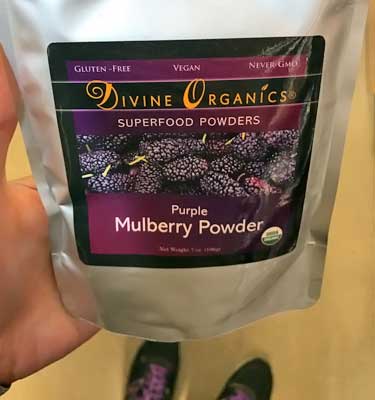
How many types are there? The Morus genus of flowering trees has been counted quite differently throughout the last couple of centuries. In 1873, the French botanist named Bureau said there were 5 species.
During the 20th century you had scientists claiming as few as 19 (Leroy in 1949) and as many as 68 (Sanjappa in 1989). Some have even claimed as many as 150 species, but the current consensus tends to be that there are 10 to 16 distinct species of mulberry trees in existence.
That consensus could change however, because the latest genetic modeling to decipher between hybrids says there are only 8 different kinds in the world (5). That was published in 2015 by a cohort of Chinese academics. Here is the list of those they identified:
- Morus alba – This white mulberry is by far the most common type that’s eaten. Originally native to China, today it’s Turkey which is the largest exporter to the US market, in the form dried fruit. It’s unlikely you will ever see fresh for sale at the grocery store.
- Morus nigra – Native to southwestern Asia, the purple or black mulberry is an even rarer treat. Even with the dried, we have never seen them for sale at any brick and mortar store in the US, but you can buy them on Amazon (we do).
- Morus notabilis – This wild mulberry species, known as chuansang in China, was not discovered until 1916 and its fruit is not sold commercially (6).
- Morus serrata – Growing at higher altitudes of up to 7,500 feet (900 m), its common name is the Himalayan mulberry, which is the native habitat you will find it.
the red variety - Morus rubra – Red mulberries are native to the eastern half of the US. They reach the lower peninsula of Michigan, but Canada is too cold of a climate for them to grow.
- Morus celtidifolia – This is another type that’s native to the Americas (South, Central, and southwestern US). The Texas mulberry, as it’s known, can grow different colors of fruit; mostly red, but sometimes purple and almost black.
- Morus insignis – This Central and South American species produces raspberry-colored reds and the fully matured can look like a blackberry.
- Morus mesozygia – The African mulberry is a favorite of chimpanzees in Uganda (7). It’s another type of black.
Buying organic is preferred, but even when they’re not, you can be confident all of the species are non-GMO. No one has tinkered genetically with this plant.
Species do differ when it comes to certain phytonutrients, but for basic values like calories and carbs, they all are quite similar. Here’s a look at the facts for the dried white version, M. alba.
Dried mulberries nutrition facts |
|||
|---|---|---|---|
| Serving Size: 1/4 cup (28g) | |||
| Calories | 90 | ||
| Calories From Fat | 0 | ||
| % Daily Value* | % Daily Value | ||
| Total Fat 0g | 0% | Vitamin A | 0% |
| Trans Fat 0g | Calcium | 6% | |
| Sodium 25mg | 1% | Vitamin C | 140% |
| Total Carbs. 21g | 7% | Iron | 20% |
| Dietary Fiber 3g | 12% | ||
| Protein 3g | |||
| *Percent Daily Values (DV) are based on a 2,000 calorie diet Source: Essential Living Foods organic white mulberries |
|||
Whether you buy that brand, Navitas Naturals, Organic Traditions, or another, all will have identical values or something very close to what you see above. For the dried white, almost all mulberries come from Turkey. They grow most exports. The only reason a given value may differ is because of moisture content or slight variances in nutrients, based on growing conditions in the region.
At 90 per serving, how many calories there are in dried mulberries is reasonable when you consider 28 grams is equivalent to a quarter cup. Now if those were fresh, that would way too many calories. Though for a dried fruit, that’s not too bad considering the amount of nutritious density packed in.
It’s not just carbs you’re eating. With 3 grams per serving, 13% of the calories are in the form of protein. How much fiber there is equals 12% of your daily value.
What do they taste like?

Let’s just say they are a daily breakfast staple for more than one of us at Superfoodly!
Dried mulberries taste like pure sugar, comparable to a fig but with a more delicate flavor. For some this taste is too sweet, however the grams of sugar they have isn’t much different than many other berries. When compared fresh, a cup of blueberries actually has more sugar (14.7 vs. 11.3 grams). (8) (9)
Unlike dried goji which are hard to chew, even a poor quality crop will still be juicy in comparison. They maintain just the right amount of moisture to be chewy, but not overly so. They also don’t get stuck in your teeth or stain, which are two drawbacks goji is notorious for.
The taste of black mulberries is less sweet, with a flavor profile that is more tart. For those reasons they’re less popular than the white. Still, they’re a pleasant variation to alternate with in your breakfast routine.
The red may be the most tart among the colors. That’s probably why no one sells them. Because of the tartness, some people even feel the need to sprinkle sugar on the red to make them palatable. That seems like a terrible idea though.
Whether it’s the white, black, or red mulberry, all fresh will be less sweet when dried. That’s because with the full water content intact, the sugars are less concentrated in the fresh fruit. However one benefit that fresh vs. dried have going for them is a more intense fig-like flavor, albeit with less sweetness and a bit more tartness. Some have compared them to almost being like a sweet grapefruit.
Mulberries vs. blackberries

When it comes to the purple or black varieties, they sometimes get mixed up with blackberries. Not so much in America, since the fresh are not sold here, but in Europe and elsewhere, many confuse them because they almost look like the same thing.
Even though they’re similar aesthetically, the differences between them are quite stark:
- When it comes to taste, black mulberries don’t have that unpleasant aftertaste which blackberries are known for.
- Similar to raspberries, blackberries grow on a shrub-like bush. Not a tall tree like all the Morus species do.
- The Rubus genus, which blackberries come from, is not closely related to the Morus genus in botany.
- One similarity they both have is that their black color comes from anthocyanins. Aside from that, their constituents differ quite a bit.
Taste, genetics, and the polyphenol profiles are night and day. The only thing they have in common is appearance, if you’re comparing to the black variety.
Mulberries vs. blueberries and goji

For 100 grams fresh, here are the ORAC values for these three as well as some others:
Goji = 3,290
Golden berries = 3,874
Strawberries = 4,302
Blueberries = 4,669
Raspberries (red) = 5,065
Blackberries = 5,905
Mulberries (white) = 6,130
Goji is the last place loser and even blueberry can’t hold a candle to the leader.
Which is better?
For overall antioxidants, that would be mulberry, but what’s best is not a black and white answer.
You will find resveratrol and high amounts of vitamin C in both fresh and dried mulberries. In fact, recent research suggests they might be the highest resveratrol fruit. By dry weight, they have 50.61 μg g−1 (10). That’s more resveratrol than what red grapes might give you.
Blueberries though are rich source of pterostilbene. This newer discovery is like resveratrol, in that it has been linked to anti-aging in research. Ketone is the primary aroma compound in red raspberries. In animal studies, it has been linked to weight loss (11). Goji is a good source of zeaxanthin and other carotenoids which have been found to support eye health (12).
Each might offer unique benefits. That’s why it’s so important to eat a variety, not just one type.
Mulberries, diabetes, and blood sugar

Is mulberry fruit good for diabetics?
It’s true there is compelling research out there suggesting this plant has a beneficial effect on glucose levels. If you look on PubMed for the name of the plant genus (Morus) and the word diabetes, you come across over a hundred pieces of research. Among those, you get five clinical trials: one from 2001, one from 2007, and two from 2015.
In the earliest study, 24 patients with type 2 diabetes were given either a “mulberry agent” or glibenclamide, which is a prescription diabetes drug sold under the brandnnames DiaBeta, Micronase, and Glynase (13). After 30 days of this treatment, they said:
“…the fasting blood glucose concentrations of diabetic patients were significantly reduced by the mulberry therapy.”

The healthy participants received leaf extract which contained high amounts of DNJ. The weight of the powder dosages used were:
- 0 g (placebo)
- 0.4 g (containing 6 mg of DNJ)
- 0.8 g (12 mg of DNJ)
- 1.2 g (18 mg of DNJ)
They were also given 50 grams of sucrose. Their blood sugar was monitored both before and after. From the results they said:
“A human study indicated that the single oral administration of 0.8 and 1.2 g of DNJ-enriched powder significantly suppressed the elevation of postprandial blood glucose and secretion of insulin, revealing the physiological impact of mulberry DNJ (effective dose and efficacy in humans).”
The 2015 trial out of South Korea was double-blind and used a 5 gram dosage per day of mulberry leaf extract for diabetics or as they referred to them, “36 subjects with impaired fasting glucose” which might mean they were only pre-diabetic (15).
After 4 weeks of this treatment, they concluded the blood sugar benefits were most noticeable 30 and 60 minutes after eating the glucose. Glycemic control was said to be improved versus the placebo group.
The other 2015 dated trial is only a publishing of protocol, not the trial results (16).
This protocol was NOT registered with the FDA. It’s in the ISRCTN registry, which means it’s only recognized by WHO (World Health Organization) and ICMJE (International Committee of Medical Journal Editors). The trial was conducted in the United Kingdom at the University of Southampton.

A total of 32 healthy adults (non-diabetics) were tested using an over-the-counter food supplement branded as IminoNorm. The dosages given were:
- 500 mg mulberry extract (IminoNorm capsule) equivalent to 25 mg DNJ
- 250 mg IminoNorm capsule, containing 12.5 mg DNJ
- 125 mg IminoNorm capsule, containing 6.75 mg DNJ
- Placebo capsule
It looks like this leaf extract was around 5% DNJ.
Near the end of 2015 they put out a press release announcing its completion, which was titled:
“IminoNorm® successfully decreases glycaemic index and broadens iAUC of common carbohydrates in clinical trial”
That was it. No published results. Why?
Phynova, the company behind it, appears to have pivoted. They dropped the terrible IminoNorm name and everything you see after 2015 about their mulberry leaf extract is called Reducose, which they describe as “a functional ingredient to promote healthy blood sugar.”
In 2017, you will find a double-blind, randomized, phase 2 crossover design published (17).
Digging into it, you will see the ISRCTN trial registration is 14597438, the same number as the 2015 study. So they did publish the trial, it just took them a while. If you can believe it, taking almost two years is not that unusual.
Those were the effects on blood sugar after consuming 50 grams of maltodextrin along with the mulberry capsules. A total of 37 people participated.
The last sentence of their conclusion stated:
“…may have multiple modes of action and further studies are necessary to evaluate the potential of ME [the extract] for the prevention of type 2 diabetes and regulation of dysglycaemia.”
Can you eat mulberry leaves? Yes, even without those special extraction methods, the whole leaf is perfectly safe to consume. That’s why some have explored using plain old mulberry leaf tea for diabetes.
PubMed didn’t categorize them as clinical trials, but there are human studies such as this example:

Afterward, the blood glucose levels average 287 for the placebo group and 210 for the leaf tea group.
Among all the studies discussed so far, one thing they have in common is the use of mulberry leaves or bark extract. It’s those parts of the plant which they’re using to make DNJ supplements, pills, and powdered extract. The berries aren’t a good source of this compound.
The same trend is seen in most animal studies (19) (20) (21) (22) (23). That said, some animal studies have tested only the fruit and claimed to observe anti-diabetic effects from it:
In diabetic mice, berry extract was found to “significantly decrease fasting blood glucose” (24). Using lab experiments, they identified 14 flavonoids in the fruit which “exhibited potent inhibitory activity against a-glucosidase.” They say that because many oral drugs for diabetes are a-glucosidase inhibitors.
In a rat study, researchers found that the anthocyanins (a class of antioxidants) seemed to help (25):
“The results from this study suggest that ANCs extracted from mulberry fruit exhibit significant anti-diabetic properties by improving blood glucose levels in ZDF rats as an animal model of type 2 diabetes.”
What is the glycemic index of mulberries?
Setting aside any purported lowering benefits, what about the impact the fruit’s sugar content will have on blood glucose?
Without citing a source, many websites report the GI as being 25. At least two do cite a source and they claim the measurement comes from Montignac Method, which is a diet that was popular in Europe during the 90’s.
We went to Montignac Method’s website and this is all we could find:
They say 25 without any additional details or source of the measurement. This is a big problem because in order to calculate glycemic index and glycemic load, you need to know the serving size.
We then turned to who is the longstanding leader in the field, The University of Sydney. Their database doesn’t include it. When you go to their FAQ, in reference to certain excluded foods such as berries, they explain why they don’t have it (26):
“…their GI cannot be tested according to the standard methodology. Bear in mind that the GI is a measure of carbohydrate quality.”
We can find nothing in scientific literature for that 25 figure, either. It’s not glycemic index, but glycemic load which would be a more appropriate metric for this food. Though even for that, no verifiable sources exist.
Verdict?
It seems like the best evidence is for the isolated DNJ compound and teas made from the leaves.
As to whether the berries might help blood sugar is even more speculative. The good news is there’s no evidence of them being worse than other berries with similar sugar content, but there is preliminary research suggesting they might be better for you.
Regardless of the form – whether extract, leaf, or whole berry – none of these purported blood sugar benefits have been proven. Just like the 2017 trial stated, more studies are needed.
For now, the only proven thing about the fruit and tea is that they taste delicious!
Does mulberry help weight loss?
The mechanism which is believed to impact glycemic levels is the same one relevant to this.
How does white mulberry work? The theory is that the lower blood sugar is from the alpha-glucosidase, which blocks the absorption of some polysaccharides (a type of carb). As a result, not all of those calories are believed to be absorbed.
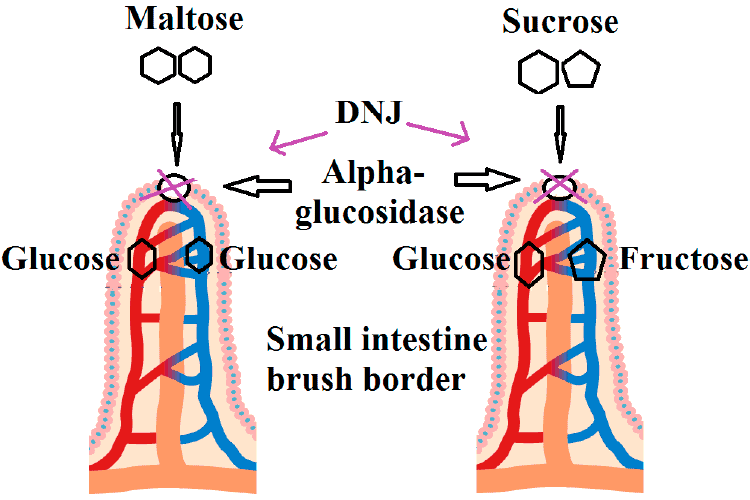
But is there any evidence to support such a claim?
To date only one human study has been conducted. Or at least, only one has qualified for inclusion into PubMed. It was conducted at a university in Rome and published in 2014 (28). Placebo-controlled, but not double-blinded.
- 46 overweight men and women were divided into two groups
- The first group was given a 2,400 mg dosage of Japanese mulberry leaf extract for weight loss.
- The second group was given a placebo.
- Both groups were placed on a low calorie diet of 1,300 calories per day.
- This went on for 90 days total.
- They checked in for weight and waist circumference measurements on day 30, 60, and 90.
The results?
Those getting the mulberry supplements lost 10% of their body weight (20 lbs or 9 kg). Those on the placebo only lost 3% of their weight (7 lbs or 3.2 kg).
Judging by the smaller waist circumference, belly fat was reduced, as well as thigh circumference in women (thighs weren’t measured on the men).
The researchers concluded that using the extract:
“…may represent a reliable adjuvant therapy in the dietetic treatment of some patients who are obese or overweight.”
Interesting, but this is just one study.

Does mulberry Zuccarin really work?
The statements on its box are “helps weight management” and “helps reduce the absorption of carbohydrates.” It claims to use standardized Japanese leaf extract, which contains the 1-DNJ compound. Since a series of human clinical trials using New Nordic Zuccarin has not been conducted, it’s really unknown whether or not it works. This supplement should not be considered proven for weight loss.
Where to buy mulberry Zuccarin includes on Amazon and on the websites of Walmart and Walgreens, but it’s not stocked in their physical stores. Aside from online, it’s not sold in Canada.
In addition to diet pills, there are a number of herbal teas which use the leaf and make similar weight loss statements. Those too have not been proven.
Mulberry fruit allergy

Kuwanon G, a compound found in the plant, was extracted from the tree bark and tested by South Korean scientists. They claimed it had an “anti-asthmatic effect” on induced allergic asthma in mice (30). “Kuwanon G reduced the numbers of inflammatory cells” they claimed.
Atopic dermatitis caused by dustmites was tested in another study (4). Not specific to the kuwanon G, but rather the whole plant extract. They used mice and monitored their blood levels of histamine and immunoglobulin E (IgE), as well as visual changes on the skin. In a dose-dependent manner, the mulberry extract reduced the dermatitis as judged by all of those parameters.
The fruit extract reduced allergic responses by suppressing a specific cell signaling pathway, according to a study using cultured cells (31).
There are several others with similar findings, too (32) (33) (34). While most use the white (Morus alba), the red mulberry (Morus rubra) is starting to be looked at (35).
Just like with diabetes and weight loss, any anti-allergy benefits of mulberry are not proven. However, at least the research so far is only suggesting this food might help, not hurt.
Side effects of mulberry
Whether you’re eating the fruit or drinking tea made from the leaves, based on the research the following adverse reactions might be possible:
- Hypoglycemia or too low of blood sugar for diabetics
- Allergic reaction (very rare)
- Unknown pregnancy safety
Unlike goji and some other fruits which have been linked to causing diarrhea, no such side effect has been noted for any form of mulberry. Neither has upset stomach, constipation, or other common dietary complaints.
In the 2017 published human trial, occurrences of these and other reactions were comparable between the placebo and leaf extract groups. Since we each have unique biological functions, any of these could happen, but their likelihood does not appear to be any greater.
Since the berries and leaves have not been studied in pregnant women and those who are breastfeeding, it is unknown whether or not they are completely safe foods in those circumstances.
There is a belief that some can make you sick. Are all mulberries edible and safe?
Where the trees grow, especially overseas, parents would often tell their children not to eat them because worms were inside. That stemmed from the fact that the leaves are the only tree the silk worm eats from. Parents were giving this warning not because they are poisonous or toxic, or that worms were in fruit (they eat the leaves). Rather, it was probably just because they didn’t want their kids to be eating wild berries in the wood!
In short, there are not poisonous types. White, black, and red are all safe to eat, assuming they genuinely are of the Morus genus.
Why are mulberries not sold in stores?
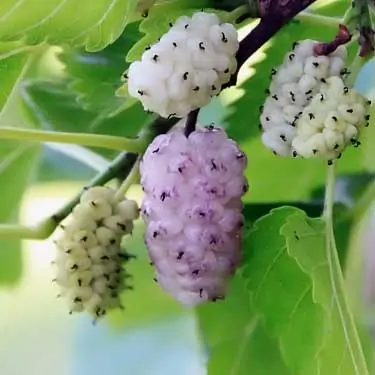
Are dried mulberries good for you?
Absolutely. As long as you buy a brand that is raw, the vitamins and antioxidants will be well preserved. Even vitamin C, which is notorious for being fragile, measures out at being 120% to 140% of your daily value per 1 ounce serving of the dried.
The other advantage dried offer is affordability, since you can buy large bags for reasonable prices. Lastly, their expiration date should be far out. They have a long shelf life of 9 to 12 months from date of processing. Compare that to the fresh berries, which are only good for about 3 days after harvesting.
How to use mulberries
Here are several recipe ideas…
- Sprinkle on your breakfast. They work for cereal, oatmeal, pancakes, and more.
- Mix with nuts to make a healthy trail mix snack.
- Fresh mulberry juice is not for sale, but you can buy juice online made from 100% organic black mulberries.
- Also for sale are jam and jelly made from them.
- Get the leaves and make a delicious caffeine free herbal tea.
This is an actual photo of the regular daily breakfast for more than one of the Superfoodly crew members.
Yes it looks naughty, but it really isn’t. It’s a basic recipe of oatmeal, this chocolate vegan protein powder, and whatever nuts, seeds, and berries are on hand.
On Amazon, a good deal is to buy the 4 pack of dried berries from Terrasoul Superfoods. That’s the brand and quantity each of us goes through in about 6 weeks. Yes, they’re kind of addictive!
These statements have not been evaluated by the Food and Drug Administration. This product is not intended to diagnose, treat, cure, or prevent any disease.

